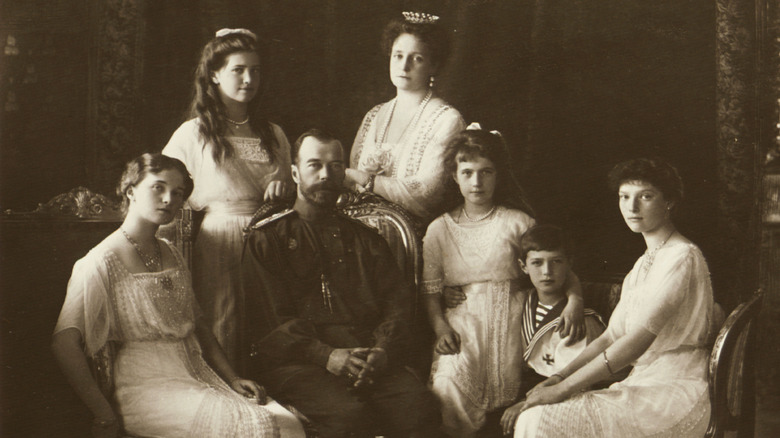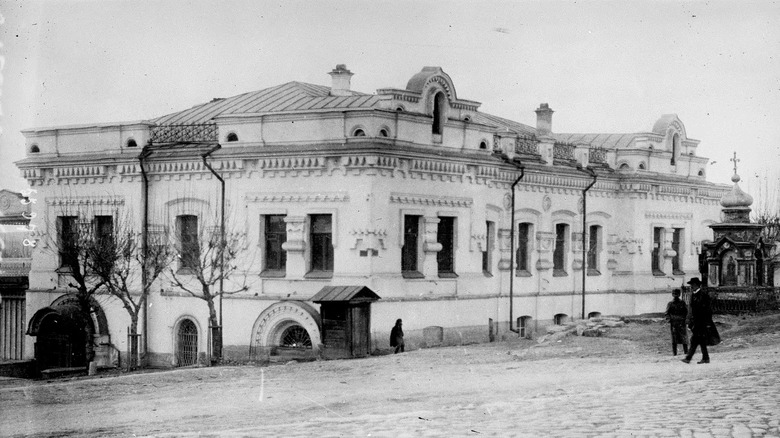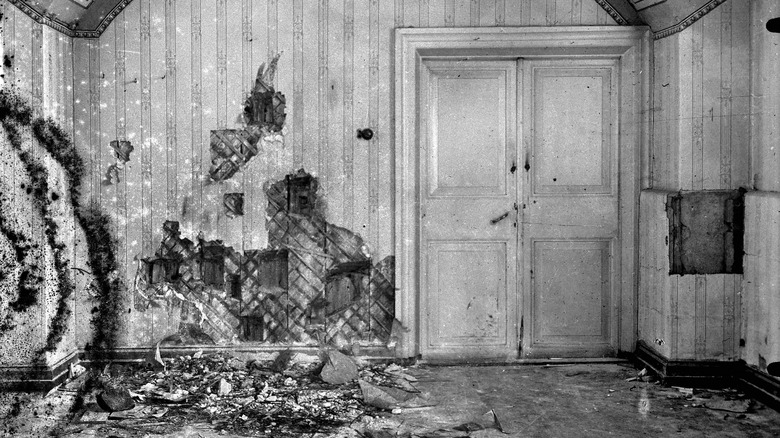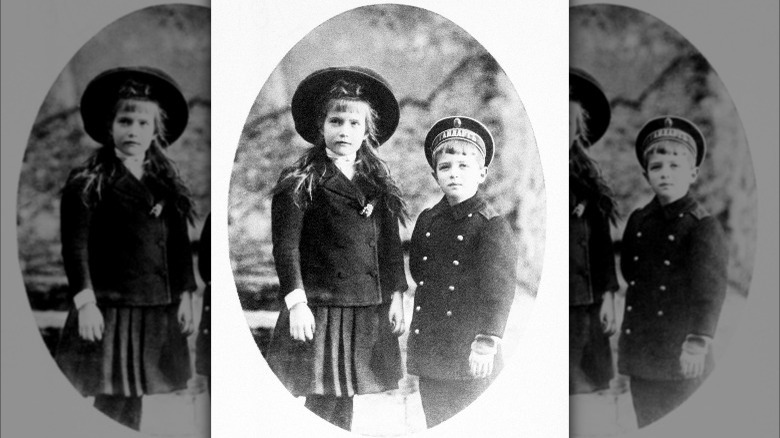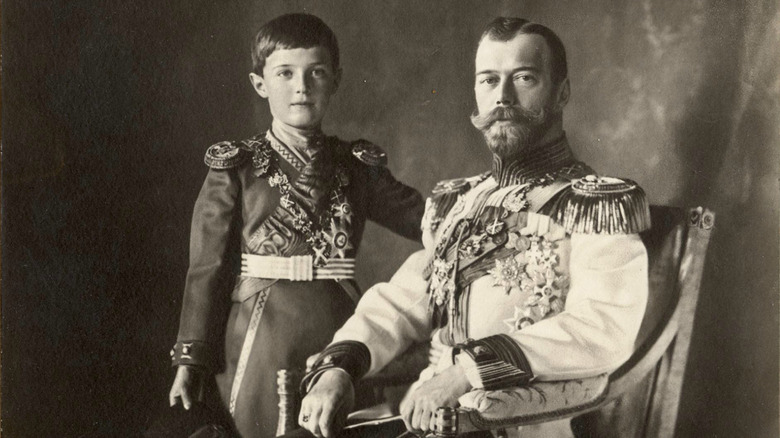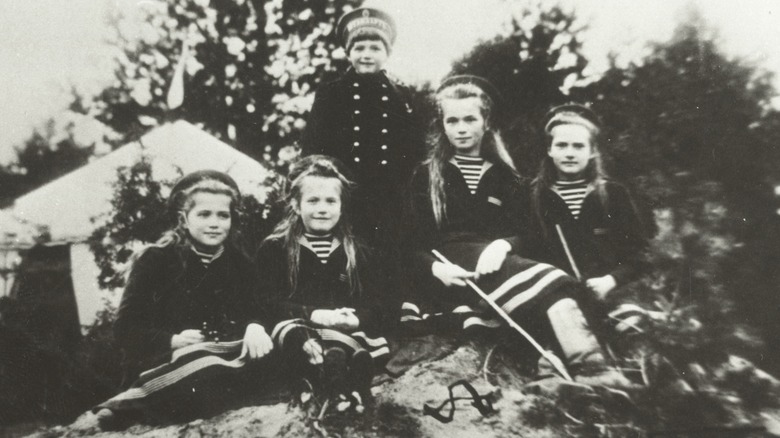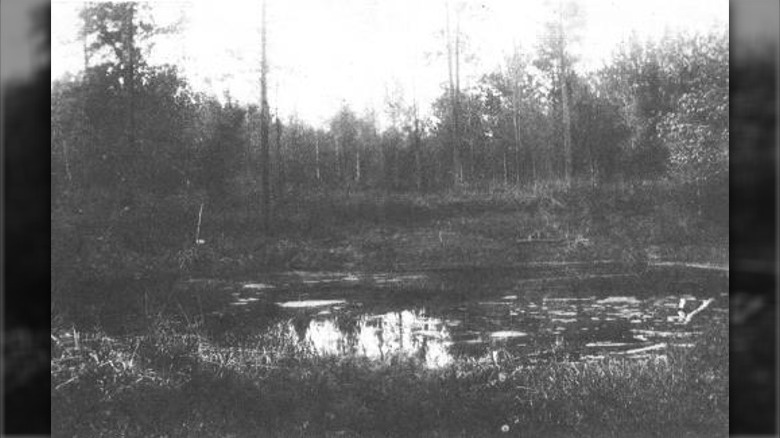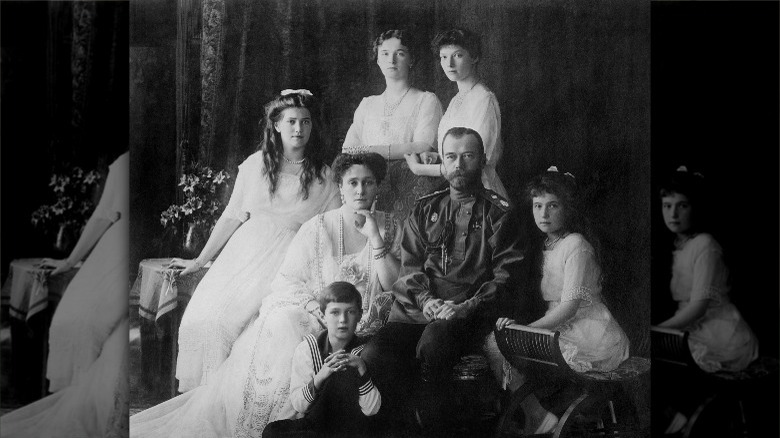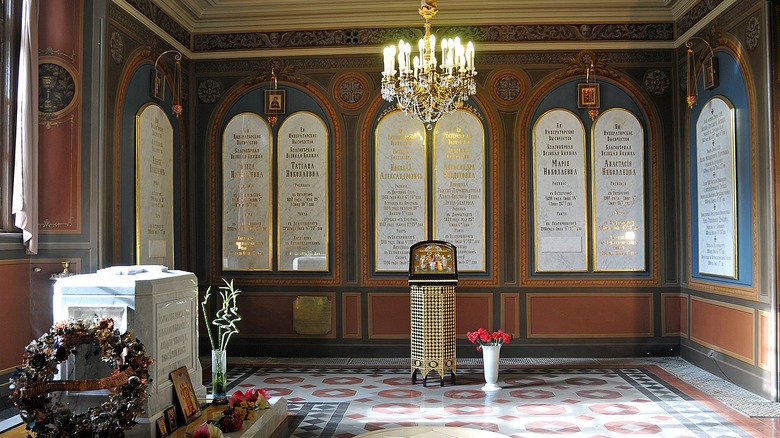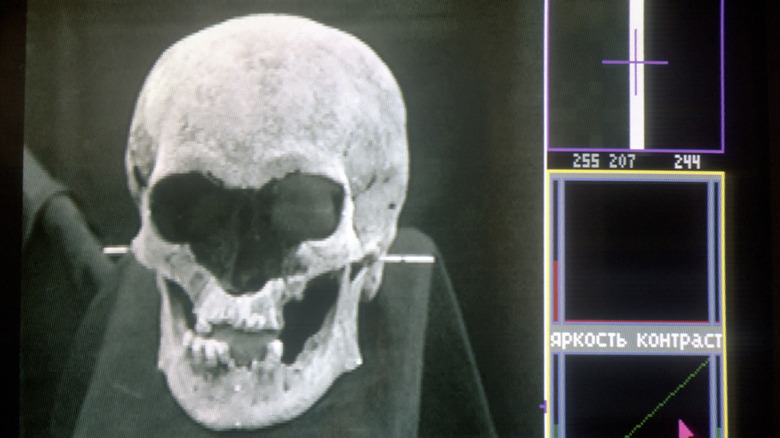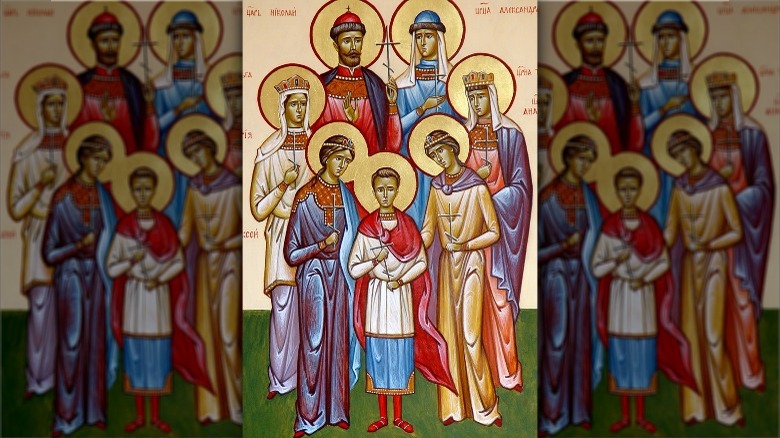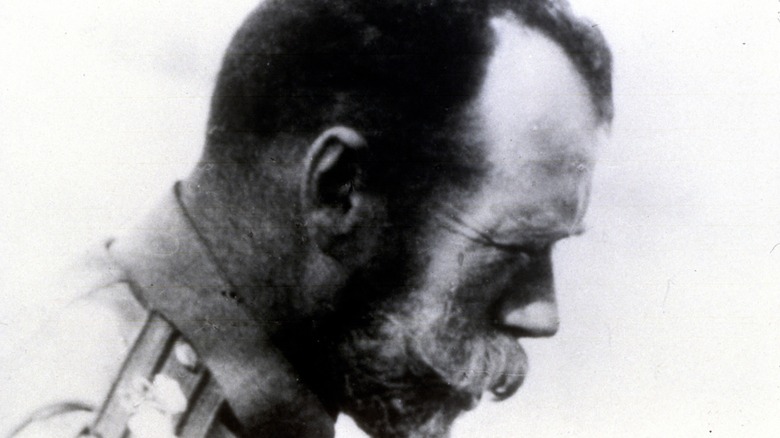What Happened To The Bodies Of The Romanov Family?
The story of the Romanov family is one that is filled with alluring mysteries. But what else could really be expected, considering the last members of the Russian royal family were central figures in one of the country's most turbulent periods of history?
But let's start this story from the beginning. The Romanovs were the longtime royal family of Russia, with a lineage that dates all the way back to 1613. The family had its fair share of famous and effective rulers, but as the 20th century approached, their standing began to dip, and it did so rather sharply. Tsar Alexander III left the country in a pretty unstable state when he died, having embraced a pretty repressive ruling style; unsurprisingly, the Russian people weren't exactly happy. His son, Nicholas II, was then left to deal with a country that was spiraling out of control, with people both angry about the past and incensed about the present.
The situation was ripe for revolution, and revolution did indeed arrive, once in 1905 and twice in 1917, alone. By the time the dust settled in 1917, the radical Bolshevik party had come out on top, preaching the ideals of communism. But a revolution is no simple thing; for one, history saw exactly what communism would do to Russia, but the Romanovs themselves would also become the basis for questions and rumors for decades to come. The truth of their final fate was just one of those questions.
The Romanovs eventually ended up in Yekaterinburg
With the Bolsheviks rising to power in late 1917, the Romanovs were left in the hands of this new government, and it should come as no surprise that it didn't exactly end well. After Nicholas II stepped down from power, the family was effectively placed on house arrest throughout much of 1917. By some accounts, that period of time actually wasn't too terrible for the family — it might have even bordered on comfortable — and they held out hope for the possibility of asylum or escape. But as 1918 rolled around, their requests for asylum were denied by foreign governments, and they were instead shuttled around the country to a number of different residences. By April 1918, the family ended up in the city of Yekaterinburg, essentially held prisoner in an old, walled-off villa known as the Ipatiev House, which Bolshevik officers rather ominously called the "House of Special Purpose."
As it turned out, that ominous name was really fitting. Plans and preparations were actively being made by the Bolsheviks to permanently put an end to the Romanov line, with soldiers stocking up on things like benzene and sulphuric acid — liquids that would be good at rendering dead bodies unrecognizable. Still, that was all kept from the family, and on July 17, 1918, they were told that they'd be moving again, only to be taken to the basement, where they were executed — a brutal and bloody 20-minute process that included guns, bayonets, and knives.
Bolshevik leaders told a very different story
The Bolsheviks didn't want the rest of the world to know exactly what happened in that basement in Yekaterinburg. But that didn't mean that they went on pretending like nothing happened.
On the contrary, party leaders made sure that the death of the last tsar of Russia at their hands was common knowledge, with Pravda, the party newspaper, announcing it while also declaring, "Nicholas Romanov was essentially a pitiful figure ... the personification of the barbarian landowner, of this ignoramus, dimwit, and bloodthirsty savage," according to "The Fall of the Romanovs" (via History). It was all a show of power, in essence. But they left out a really big part of the story in claiming they'd only killed the tsar; according to them, the rest of his family was still alive, just out of the public eye.
That decision ended up backfiring in some pretty odd ways. The news was intended as a way to signal that the monarchy — shackles that the Russian people had to shake off in order to really move forward — was now in the past, almost like a rallying cry to drum up support for the Bolshevik cause. Instead, the tsar's death became a huge piece of news on its own, and the revolutionary ideology got kind of lost. Some people even started to miss the monarchy and wish for it back (though that might have been bolstered by the Bolsheviks purging Romanov relatives and acquaintances shortly later).
Rumors and speculation on the streets
If you've heard of the Romanov family, there's probably a chance you know of them because of the popular myth about Anastasia Romanov — the theory that the youngest daughter of Tsar Nicholas II somehow managed to survive the brutal execution of her entire family.
When you look at the response to the news of Nicholas II's death — the nostalgia for the old monarchy — and the simple fact that the Bolshevik Revolution heralded a lot more terror and oppression than the high-minded ideals it promised, then it's not hard to imagine why people would like to think that one of the Romanovs had survived. Combine that with the initial claims that the tsar's family had been spared (which eventually turned into late and incredibly vague reports about what had actually happened that night, once information began to get out), and the fantastical speculations almost started seeming possible.
Almost immediately, people began to pretend to be surviving members of the Romanov family — a trend that would continue throughout the entire 20th century — with most of the imposters claiming to be one of the tsar's two youngest children, either his son Alexei or youngest daughter Anastasia. These actors crafted colorful tales to explain what had happened, and their stories actually kept peoples' hopes for a real-life fairy tale to come true. It was all proven to be fiction in the end, but some of those imposters, notably Anna Anderson, actually garnered sizable numbers of supporters.
Decades passed before any of the Romanovs were found
Following the deaths of the Romanovs in 1918, years came and went with most people still unsure of the details of what happened and where the Romanovs were actually laid to rest. But that didn't mean people weren't looking. The search actually started the very same year that the Romanovs were killed, but while investigators could piece together some of the events, no remains were found.
There was nothing for decades after that, until the 1970s, at which point a geologist named Alexander Avdonin started an amateur investigation of his own. Against the odds, while searching with his son in 1979, he found the Romanovs' remains. He even began digging up the remains before thinking better of it; the political situation of the Soviet Union in the 1970s was still sticky, to say the least, so he played it safe and reburied the bones.
But then things changed once again when Mikhail Gorbachev came into power. Without getting into the details, Gorbachev championed openness within the Soviet Union, loosening many of the restrictions on information that had been kept secret for years. And that was the perfect time for Avdonin to make his discovery known. An announcement was made in 1989, and two years later, an official team recovered the remains of nine bodies — the tsar, his wife, three of their daughters, and four of their servants and associates. But that raised another important question: Where were the other two children?
The mystery was solved in 2007
Perhaps it's unsurprising that the discovery of a mass grave that was missing two of the Romanov children would end up causing a resurgence of interest in the theory that members of the royal family had survived. And that was only bolstered by the specification that it was Alexei and one of the daughters — either Maria or Anastasia (though most likely the former) — who wasn't buried with the rest of the family. If they weren't there, then maybe the theory was true after all, right?
The theory would be soundly debunked in 2007, though. Sergei Plotnikov was a member of a club focused on locating the remains of the last two Romanovs, and he happened to be searching a bit of land near the already-discovered grave. As it turned out, he'd happened upon the one relatively small plot that the original investigation from the 1990s hadn't searched, due to a lack of funds. Suddenly, his tools collided with something hard underground. Upon digging, he and a friend started to unearth the badly damaged shards of bones from two individuals; he knew exactly what he'd found, remarking later, "It was clear they didn't die peacefully" (via The Guardian).
It took little time after that for experts to verify the findings. These were, almost certainly, the remains of Alexei and Maria Romanov, buried in a second grave not far from the rest of their family.
The Bolsheviks had tried to hide the bodies
As it turned out, the journey of the last members of the Romanov royal family hadn't ended with their death, instead continuing along a fairly strange path as the Bolsheviks tried to deal with their remains. After all, the stockpiling of sulphuric acid and benzene made it clear enough that the Bolsheviks had every plan to hide what happened in Yekaterinburg.
The bodies of the Romanovs were taken from the Ipatiev House and taken out to the surrounding forests to be hidden away. They were stripped of their clothes and jewelry — some of which had been sewn into their clothing and acted like bulletproof armor, explaining just why the execution had taken so long — and then disfigured with acid. From there, they were unceremoniously thrown into the Ganina Yama mine, which was to be blown up and subsequently sealed via grenade blasts. For a while, that was actually where people believed they had been buried.
But as it turned out, the mine was especially shallow, so the grenades didn't really collapse it in the way that the Bolsheviks had hoped. The bodies of the Romanovs hadn't been buried in the process, and that led to the fear that passersby might be able to easily stumble upon them. That was obviously the last thing that the Bolsheviks wanted to happen, and so in a scant couple of hours, the bodies were retrieved from the rubble and loaded into a truck again.
Two graves was not the original intention
To say that the initial plan to bury the bodies of the Romanovs went poorly would be a massive understatement. And saying that the situation became more straightforward from there — that would just be incorrect.
After the mine failed to collapse and adequately bury the bodies, they were loaded up to be taken to a new burial location, but even getting to that new location ended up being a problem in and of itself. While in transit, the truck had to drive through an especially wet and muddy area, and its weight actually caused it to start sinking into the mud — stuck. The solution that the Bolsheviks came up with at that moment? Removing two of the bodies — Alexei and Maria — then burning and burying them on the spot, the Bolsheviks hastily threw them into a shallow grave so that the truck could continue on.
That said, the rest of the convoy didn't go all that much further. The remaining members of the Romanov family were buried just off to the side of Old Kaptikovskaya Road, not all that far away from the other two children. But regardless of the relatively short distance, the simple existence of the two separate graves ultimately sparked plenty of questions and myths.
The family still isn't reunited
Well over a century has passed since the murder of the Romanov family, and years have passed since the family's remains were discovered. But that is far from meaning that their fate has been fully decided.
After the discovery of the first grave, it was decided in the '90s that all of the bodies would be buried in St. Catherine Chapel in the city of St. Petersburg, the same place where generations of Russian tsars had been buried. The official service took place in 1998. A couple of years later, word also came out that all seven of the Romanovs — Tsar Nicholas II and his immediate family — would be canonized as saints in the Russian Orthodox religion. But all of that came with controversy, including questions as to where the bodies should be buried and doubts about the authenticity of the remains. In fact, at no point during the ceremony did the church ever explicitly recognize that these were the bodies of the Romanovs.
That controversy never really died down, and it just became all the more complicated with the discovery of Alexei and Maria's remains a few years later. Once again, the church refused to recognize them as the Romanovs, and they even refused to bury them with the rest of the family. Rather, their remains languished in sealed boxes in the State Archives until 2015, at which point the church did take them, but for analysis, not burial.
[Featured image by Dennis Jarvis via Wikimedia Commons | Cropped and scaled | CC BY-SA 2.0]
DNA testing basically proves the authenticity of the remains
When the two different graves were found, there was quite a bit of immediately available evidence that seemed to point to the bodies being those of the Romanovs, from the bullets buried in the ground to the brutalized state of the remains. It lined up with what was understood about the fate of the family.
A more detailed analysis would eventually provide evidence that's pretty irrefutable, though. Plenty of DNA tests run over the years have all come back with promising results. The remains were compared against the DNA of Nicholas II's brother, as well as a known DNA sample of Nicholas II, himself, which was sourced from a bit of blood spattered on the tsar's shirt and subsequently preserved. Further digging into genetics also compared the DNA of the remains to indirect descendants of the Romanov family (such as Prince Philip). If that wasn't enough, then in 2015, a request from the church even allowed a team to disinter the body of Nicholas II's father, Tsar Alexander III, just for the purpose of this genetic test. By 2018, the investigators weren't mincing words anymore: "They are father and son" (via Phys Org). It would seem pretty hard to argue with the science of genetics.
The Russian Orthodox Church is stalling for time
Most people recognize the bodies found in those two graves near Yekaterinburg to be the remains of the Romanov family. But not everyone does.
Pretty much from the start, the Russian Orthodox Church has refused to acknowledge the bodies as those of the Romanovs or to accept the widely recognized narrative of what happened to them. But they have no alternative explanation. They've mostly just claimed that they need 100% certainty before making any official statement and used that explanation to stall for time, ordering more and more analyses. In doing so, they've both rejected strong evidence that the remains are authentic and entertained far-fetched conspiracy theories which technically support their point of view. At one time, they even considered the notion that the tomb of Tsar Alexander III had been broken into and his remains stolen, just to, essentially, cheat the DNA testing — a theory that was swiftly debunked.
Due to the lengths they're going to, many people assume there's more to this, and that the reasons are more political than academic. For the church, making an official statement on the authenticity of the remains is actually a potentially huge deal. Significant portions of Russian Orthodox practitioners want the Romanov remains officially recognized, and significant portions want the exact opposite. It's a lose-lose situation that's guaranteed to court controversy and potentially prompt a schism; remaining in the gray area of uncertainty might be a way for them to avoid that.
[Featured image by Aliksandar via Wikimedia Commons | Cropped, scaled, and mirrored | CC BY-SA 3.0]
What's the reason for the controversy?
The questions surrounding the Russian Orthodox Church's reluctance to recognize the remains of the Romanovs as authentic all get pretty twisted and complicated fairly quickly. It's a whole mess of controversy, really.
At its heart, that controversy stems from the Romanovs' — or, more specifically Nicholas II's — place in history. On one hand, it's hard to deny the family's deaths were horrific. Boris Yeltsin, the president of Russia at the time, summed it up in his own speech, saying, "The Yekaterinburg massacre has become one of the most shameful episodes in our history. By burying the remains of innocent victims, we want to atone for the sins of our ancestors" (via The New York Times). The violence in the execution (and the violence it subsequently led to throughout the century) is something that can't just be ignored. And there's certainly something to that argument.
But at the same time, you also can't turn a blind eye to the central role that the Romanov family played in the Russian Revolution. Nicholas II was far from an effective leader, his political missteps pushing the country toward growing unrest. He wasn't an especially popular leader, either, both at the time and in hindsight. The decisions made by the Romanov leaders set the stage for the Bolsheviks to take power, so they could arguably even bear some responsibility for everything that happened afterward, too. Is that a legacy that should be remembered fondly, gruesome death or not?
